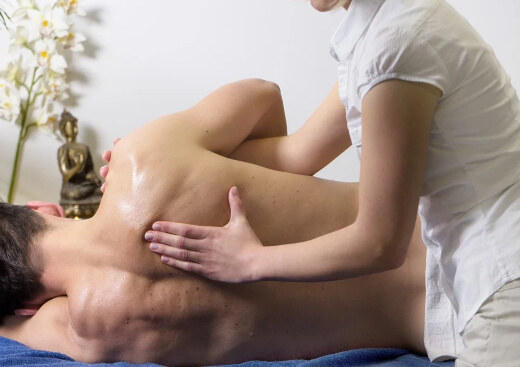Frozen shoulder isn’t only uncomfortable and stiff, it can also be painful. But it can be treated with OTC medication and simple frozen shoulder exercises.
The AEPs at Sydney Sports & Exercise Physiology can personalize an exercise plan that will help you improve your range of motion and reduce shoulder pain.

What is Frozen Shoulder?
Your shoulder has three bones. The shoulder blade (scapula), collarbone (clavicle) and the upper arm (humerous). These bones are held in place by a tissue called the shoulder capsule.
Frozen shoulder occurs when the shoulder capsule thickens. It becomes tight and thick making it hard to move. This condition often involves pain. It usually begins gradually and gets worse.
Over time, the shoulder can thaw, and motion will improve. However, this does not happen right away. Thawing often takes 6 months to 2 years, but can take upwards of 3 years.
Frozen Shoulder Symptoms
The most common symptoms of frozen shoulder are stiffness and pain. These can make it hard or unbearable to move. Pain often starts off as a dull ache that can get worse at night when trying to sleep.
There are three phases of a frozen shoulder. They are:
Freezing Stage
This is the stage where you begin to develop pain and stiffness. It gradually gets worse and can make sleeping difficult. It can last from 6 to 9 months.
Frozen Stage
During the frozen stage the pain may begin to subside, but the stiffness often gets worse. It can be almost impossible to move your shoulder.
This can make everyday tasks hard to accomplish. This stage often lasts anywhere from 4 to 12 months.
Thawing Stage
Range of motion begins to return during the thawing stage. It can take 6 to 12 months to regain full movement.
Frozen Shoulder Treatment
Frozen shoulder usually gets better, but it can take a long time. Frozen shoulder treatment is used to help control pain, restore motion, and improve strength.
Physical therapy is often used as a treatment. In some cases, your doctor may suggest surgery if the symptoms are not helped with therapy.
Non-surgical treatments include:
- Anti-inflammatory medications such as ibuprofen or acetaminophen
- Steroid injections
- Hydrodilatation
- Physical Therapy

Surgical treatments include:
- Manipulation under anesthesia
- Shoulder arthroscopy
Frozen Shoulder Causes
Frozen shoulder isn’t fully understood. It happens less often in men than it does women. It usually happens to those that are between 40 to 60 years of age.
There has not been any connection found between hand dominance or occupation. However, there are some factors that may make some individuals more at risk than others.
These factors are:
- Diabetes
- Cardiac Disease
- Parkinson’s Disease
- Hypothyroidism
- Hyperthyroidism
Frozen shoulder can also occur if a patient has their shoulder immobilized for a long period of time after surgery.
Exercise Rehabilitation
Exercise rehabilitation plays an important part in the recovery process. Rehab will help you improve your range of motion and reduce pain. Our personalized frozen shoulder exercise plan will help improve flexibility, restore muscle strength, and bring back full function.
To heal properly it is important that you start an exercise programme soon after the onset of frozen shoulder. Exercise rehabilitation exercise physiology allows us to treat each client differently.
You will receive a personalised plan that will help you achieve your physical goals. Exercise rehabilitation is often overlooked be is necessary for a full recovery.
Frozen Shoulder Exercises

Performing tasks when you have a frozen shoulder can be impossible. Proper stretching and physical therapy exercises can improve your range of motion and relieve pain.
Before stretching, it is important to warm up your muscles. A couple of ways to do this is by taking a warm shower or placing a warm towel over your shoulder.
Stretching Exercises for Frozen Shoulder
Pendulum Stretch
Standing, lean over slightly. Allow your arm to hang straight down. Swing the arm in small circles.
Cross-body Arm Stretch
With your opposite hand grab your arm just above your elbow. Pull the affected arm across your chest till you feel a stretch.
Armpit Stretch
Sit up straight. Turn your head to the opposite side of your frozen shoulder. Grab the back of your head and pull it down to your armpit.
Arm Circles
Stand up straight. Place your feet shoulder-width apart. Raise your arm straight out to the side. Slowly rotate your arm forward in small circles. Once you complete a set, rotate your arm backwards.
Towel Stretch
Use a 3’ long towel. Stand up straight. Hold the towel with one hand and drape it behind your back. Grab the opposite end with your other hand. Pull up and then down on the towel.
Getting Relief at Home
When you are in pain relief is all you can think about. There are some things that you can do at home to relieve the pain:
- Take OTC pain relief medications
- Use a warm compress. Be careful that it is not so hot that it will burn you.
- Take a hot shower.
- Perform frozen shoulder exercises and stretches after the shoulder is warmed up.
Sleeping with a Frozen Shoulder
If you are suffering from frozen shoulder sleeping can be difficult. Here are a few ways that you can do to make sleeping easier:

Over the Counter Pain Relievers
Pain relievers can help alleviate the pain. Take an over the counter pain reliever shortly before you go to bed.
Do not Sleep on Your Frozen Shoulder
Putting pressure on the injured shoulder can make the pain worse. Instead, sleep in a different position.
Use a Pillow
If you move a lot during your sleep and roll onto your shoulder use a pillow. Situate a pillow into a position that will prevent you from rolling.
Keep a Sleep Schedule
Go to bed and get up at the same time. By doing so, you are helping to set your internal clock. This will help your body get to sleep.
Avoid Stimulants
Stimulants such as alcohol, caffeine and nicotine can make it hard to go to sleep. Avoid these in the evening, so they do not interrupt your sleep schedule.
Stretch and Exercise
Performing exercises and stretches will improve blood flow and help reduce shoulder pain. When exercising, do not stretch to the point that you feel pain. You should only feel a strong stretch.
Don’t Overdo It
You know your body’s limitations. Do not overwork your shoulder and cause unnecessary irritation.
Start Rehabilitating Your Frozen Shoulder Today
The earlier you start rehab the quicker you can get back to your old self. If you are experiencing a frozen shoulder, contact one of our Sydney Sports and Exercise Physiology locations.
